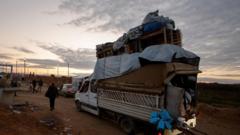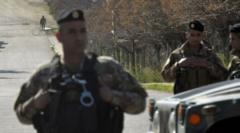The recent withdrawal of Israeli troops from the Netzarim Corridor, which divided Gaza, allows for the return of displaced Palestinians who encounter severe destruction. The situation unfolds amidst ongoing negotiations for a ceasefire and an impending visit by an Israeli delegation to Qatar for further discussions.**
Israel Withdraws Troops from Gaza Corridor Amid Continuing Ceasefire Negotiations**

Israel Withdraws Troops from Gaza Corridor Amid Continuing Ceasefire Negotiations**
As Israeli forces retreat from the Netzarim Corridor, Gazan residents return to destroyed homes amidst a fragile ceasefire agreement facilitating prisoner exchanges.**
Israeli troops have completed their withdrawal from the Netzarim Corridor, a strategic military area that had separated northern Gaza from the south. This move comes as part of the ongoing ceasefire agreement established in mid-January, which aims to facilitate the release of 21 Israeli hostages alongside 566 Palestinian prisoners. Initial reports indicate that upon their return, many Gazans, traveling in cars and on carts loaded with possessions, have encountered devastating scenes of destruction in their homes.
The ceasefire, which is set to progress in stages, aims for the release of a total of 33 hostages and 1,900 prisoners, although it has been reported that out of the 33 hostages, eight have already been confirmed deceased. Following the start of the conflict triggered by a Hamas attack on October 7, 2023, the toll has been severe; over 47,500 Palestinians have reportedly died, and extensive damage has been inflicted on Gaza's infrastructure.
Initially, around 700,000 residents of northern Gaza had evacuated to the southern regions as Israeli ground operations commenced. Many of them subsequently faced multiple displacements due to escalating military actions. The Netzarim Corridor, which was a primary route, restricted their return, compounding the challenges faced by displaced families.
Recently, Israeli forces had previously begun withdrawing from parts of the corridor, allowing pedestrian movement along Rashid Street. Sunday’s withdrawal of troops from the eastern portion signifies a shift in Israeli strategy; however, control over Gaza's borders remains with Israeli forces, while residents must navigate through stringent security measures.
Parallel to the troop withdrawal, an Israeli delegation is expected to travel to Qatar for negotiations, focusing initially on "technical matters" related to the ceasefire, rather than tackling the more intricate issues that include longer-term solutions and potential permanent ceasefire arrangements. Israeli Prime Minister Benjamin Netanyahu, returning from meetings in the US, is central to these discussions.
During his recent trip, Netanyahu engaged with US President Donald Trump, who has proposed a controversial vision for Gaza, suggesting the territory's civilian population be relocated—a stance sharply criticized and rejected by both Arab states and international bodies citing potential violations of Palestinian rights and international law. Egypt has called for an emergency Arab League summit to address what it deems "serious developments" affecting the Palestinian situation.
As the region faces a precarious balance between potential peace and ongoing conflict, the return of displaced Gazans highlights the urgent need for sustainable solutions amidst the humanitarian crisis.




















